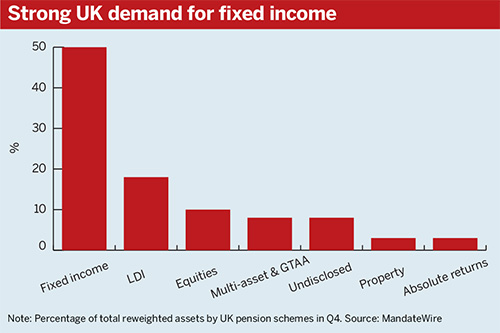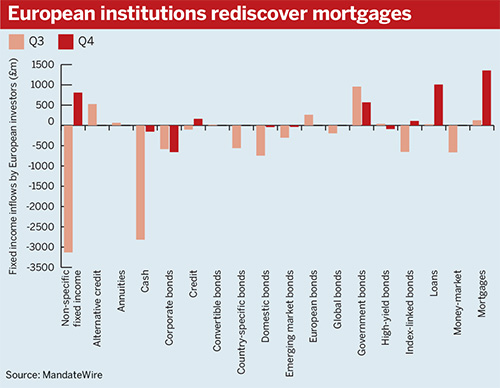Corporate schemes shore up portfolios with fixed income and LDI allocations
Data analysis: UK corporate defined benefit schemes upped their allocations to fixed income in the last quarter of 2015, data show, as trustees took the opportunity to hedge out further risk by increasing liability-driven investments.
Many schemes were locking in gains from a late-year stock rally by moving into bonds, according to data from Financial Times service MandateWire.
Fixed income inflows by the European schemes surveyed surpassed the £3bn mark in Q4, compared with negative net outflows in Q3.
The leverage embedded in LDI programmes is freeing up capital, and has often been re-employed in more diversified fixed income portfolios
The Pension Protection Fund and the Pensions Regulator’s 10th annual Purple Book published late last year, which tracks trends across DB schemes, found that gilts and fixed income now account for almost half (47.7 per cent) of schemes' asset allocations, up from 44.1 per cent in 2014.
The data show that of the assets increased by UK private pension schemes, 50 per cent were reweighted to fixed income in Q4, compared with 26 per cent in the previous quarter.
The data also show that 18 per cent of assets in Q4 were reweighted to LDI and structured products.
John Belgrove, senior partner at consultancy Aon Hewitt, said: “Despite an historically low gilt yield environment we continue to see strong demand from UK DB pension fund trustees for new, or extensions to, LDI mandates.”
He added that there may be greater acceptance of a 'lower for longer' interest rate outlook, which has helped overcome barriers to increasing hedge ratios for those who were waiting for better timing opportunities to come.
Belgrove said he expected appetite for LDI and fixed income to go hand-in-hand.
“The leverage embedded in LDI programmes is freeing up capital that is often taken up by buy-and-hold gilt and corporate bond portfolios, and in seeking that extra bit of return and flexibility has often been re-employed in more diversified fixed income portfolios,” he said.
A recent report questioned whether asset derisking has gone too far. Released by consultancy Redington last month, the report found that UK DB schemes have removed nearly half their funding level risk over the past decade.
The report suggested this was achieved mainly by reducing asset-side risk, rather than hedging liabilities, raising questions about whether schemes are able to generate enough returns to meet long-term funding targets.
Redington suggested that schemes seek out riskier assets to sit alongside LDI portfolios.
Alternative credit strategies
MandateWire data show that non-traditional fixed income assets proved popular among investors looking to diversify portfolios. European investors ploughed nearly £1.4bn into mortgages in Q4 last year, compared with inflows of just £128.8m in the previous quarter.
Loans also saw inflows of £1bn in the last quarter of 2015, whereas corporate bonds saw outflows of £658m and government bonds had inflows of £576.3m.
William Parry, investment consultant at Buck Consultants at Xerox, said: “Mostly where we see alternative credit being used is alongside the LDI allocation.”
He added that this allows schemes to retain some liquidity to adjust hedging accordingly.
Parry said that if liquidity is retained, returns are likely to be around Libor plus 2 per cent to 4 per cent, which is akin to investing in corporate bonds.
He said that multi-credit strategies are starting to gain in popularity, as with these products schemes are moving across the liquidity spectrum and up the risk-return spectrum without adding interest rate sensitivity.
Most Viewed
- What does Labour have in store for the pensions industry?
- LGPS latest: GLIL backers invest £475m for UK infrastructure push
- Dashboard costs rose by 23% in 2023, figures show
- Border to Coast launches UK strategy in major private markets push
- How the pensions industry can better support people with mental health problems



